Top News
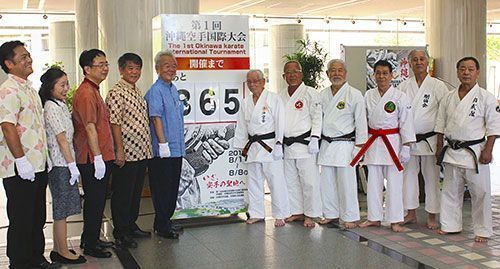
August 1, 2017 Ryukyu Shimpo
On August 1 the executive committee for the Okinawa Karate International Tournament held an unveiling ceremony at the Okinawa Prefectural Office for a display counting down the number of days to the first time this tournament will open, which will be on August 1 next year.
Vice Governor of Okinawa Moritake Tomikawa, a deputy head of this executive committee, gave a comment in lieu of Governor Takeshi Onaga who heads the committee.
Tomikawa read: “It is said that karate, which was born in Okinawa, has spread to 130,000,000 enthusiasts throughout the world.
[Karate’s popularity] is expected to steadily grow through its accepted addition to the programme for the Tokyo Olympic Games.
We hope that karate enthusiasts at home and abroad will attend the tournament in Okinawa, karate’s birthplace, honing the art and deepening cultural exchange.”
Another deputy head of the executive committee, the Karate and Kobujutsu Preservation Society President Ryuko Tomoyose, also attended the unveiling ceremony.
He said that an international karate tournament in Okinawa has been a long time coming, and his heart jumps for joy at the thought that it is getting closer and closer to being realized.
Tomoyose earnestly wishes for the tournament to come together successfully.
President of the Federation of All Okinawa Karate Masanobu Sakagawa, also a deputy head of the same committee, stated: “Today, karate is extending throughout the world in a big way.
Even in historical context holding an international tournament is remarkable.
It will be my pleasure if this opportunity increases tourism through Okinawa’s karate and culture, contributing to the growth of Okinawa.”
(English translation by T&CT and Erin Jones)
Go to Japanese
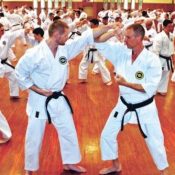
July 31, 2017 Ryukyu Shimpo
The Shima-ha Shorin-ryu Karate Federation kicked off their training camp July 30 at the Okinawa Budo-kan, assembling approximately 130 karate-ka from eight countries and regions outside of Okinawa including China, the U.S., Germany, Denmark, and South America.
The training camp is scheduled to last one week, until August 5. People who study other styles of karate also participated, learning to use and move their body in a familiar way expanding on their style of karate.
The Shima-ha Shorin-ryu Karate Federation gathers students from all over the world about once every three years for a training camp.
Master Toshihiro Oshiro, one of the instructors teaching at the camp, emphasized, “I want the students to go home having learned what kind of martial arts and techniques have been passed down from ancient Japan.
These basic movements lead to some of the most advanced ones.”
Florian Fischer (34), who came from Munich, Germany to take part in the camp, said smiling, “In my 25 years since starting karate, I have had around 100 students.
[At the camp] I would like to learn advanced techniques.
This is also a great chance to meet people from different countries and have valuable interactions.
” With regard to karate, Fischer added, “Even after learning one thing, there is always another level.
I would love to get even a little bit close to Master Oshiro.”
(English translation by T&CT and Sam Grieb)
Go to Jpapanese
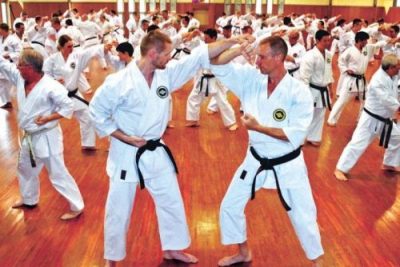
Photograph: 130 karate-ka from all over the world taking part in the karate training camp. July 30, Okinawa Budo-kan in Naha
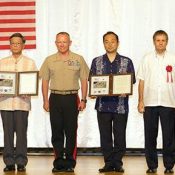
August 2, 2017 Ryukyu Shimpo
On August 1, at a hotel in Ginowan, the Japanese government and Ginowan City held a land return ceremony. The United States government returned about four hectares, a part of land which is located on the east side of the U.S. Marine Corp Air Station Futenma (about 481 hectares), to the Japanese side on July 31.
The returned land will be maintained as part of Ginowan City Route No. 11 after any environmental impacts have been removed.
The land accounts for a mere 0.8% of the whole Futenma airfield.
The government had hoped to highlight the result of its efforts to reduce the base burden on Okinawa. Instead, in his speech at the ceremony, Okinawa Governor Takeshi Onaga sought again to relocate the Futenma base out of the prefecture.
Meanwhile, the central government continued to show support for the Henoko relocation plan.
The ceremony has highlighted once again the deep rifts between the central government and the prefectural government over the “burden reduction”.
Governor Onaga said he welcomed the returned land being used for the city road because, he said, it will contribute to improving the living environment.
However, he asked the central government to grapple with relocating the Futenma base out of the prefecture and give the highest priority to protecting the neighboring people’s lives and properties.
Ginowan Mayor Atsushi Sakima said it was a step toward the whole return of the Futenma base.
Parliamentary Vice Defense Minister Hiroyuki Miyazawa said, “We will do everything in our power to reduce the base burden on Okinawa.”
Miyazawa maintained the government’s approach to promote support of the new base in Henoko, saying, “We must produce the results in a certain manner while continuing efforts to gain local understanding.”
(English translation by T&CT)
Go to Japanese

July 28, 2017 Ryukyu Shimpo
On July 27 it came to light that spanning the eight years between 2008 and 2015, out of the number of reported crimes committed by U.S. Forces, Japan (USFJ) military personnel, civilians in military employ, and their families living in Japan, those crimes committed in Okinawa accounted for 47.4 percent of all such crimes domestically. A study group on the U.S. base burden that has been established within the National Governors’ Association aggregated this information.
Out of military facilities for exclusive use by the USFJ, the high proportion of 70.4 percent is in Okinawa. On top of aircraft noise damage and risk of aircraft crashes, harm caused by crime is another of the many burdens putting pressure on Okinawa, once again thrown into relief by this study.
According to the study group on the U.S. base burden’s study, over eight years starting in 2008 the number of reported criminal cases committed by persons related to the USFJ in Okinawa alone has oscillated between 39.8 to 54.7 percent of these cases domestically. Cumulatively over those eight years there have been 1025 cases reported, of which Okinawa has accounted for 486, or 47.4 percent.
This study group was established in July 2016 within the National Governors’ Association in response to Governor Takeshi Onaga of Okinawa entreating the governors of other prefectures to “earnestly consider the Okinawa military base issues as if these were their own affairs.”
Governor Kiyoshi Ueda of Saitama Prefecture chairs the study group. Membership consists of eleven prefectural governors including Kyoto’s governor Keiji Yamada who is president of the National Governors’ Association, and the governor of Kanagawa Prefecture Yuiji Kuroiwa, who also chairs a liaison council of governors with U.S. bases in their jurisdictions.
Up to this point the study group on the U.S. base burden has held three meetings. In addition to hearing out Governor Onaga on the current status of the military base burden on Okinawa, the study group has also engaged in activities such as inviting Professor Narushige Michishita of the National Graduate Institute for Policy Studies to speak about the U.S.-Japan alliance. On July 28 Ueda, as chair of the study group, reported on these activities at the National Governors’ Association meeting in Iwate Prefecture.
In Okinawa in April 2016 an Okinawan woman was assaulted and killed by a civilian in U.S. military employ. In response to this incident the central government allocated funds to a “Patrolling Party for Okinawa Community Security,” and decided to install measures such as security lights and cameras in each community. The prefectural police have recruited 100 police officers to assign to these patrols since January 2017.
(English translation by T&CT and Erin Jones)
Go to Japanese

July 23, 2017 Ryukyu Shimpo
In the first-ever fact finding survey conducted by Okinawa Prefecture with the goal of promoting and passing down traditional Okinawa Karate and Kobudo, it was discovered that outside of Okinawa, 65.5% of people did not know that Okinawa is the birthplace of Karate. A lack of inheritors, and the fact that most people cannot survive on Karate alone are issues well known within Okinawa. This was announced by the Okinawa Karate Promotion Office July 22.
Compared to the 96% of respondents within Okinawa who answered, “Okinawa is the birthplace of Karate,” outside of Okinawa only 34.5% gave the same answer. Even among the respondents from outside the prefecture who answered as such, 21.8% said they were” vaguely aware,” 1.6 times the people who were “certainly aware,” at 12.8%. Currently, the total number of Karate enthusiasts, including internationally, is around 130 million people, which only serves to highlight the low awareness numbers outside of Okinawa.
Worries held by Karate dojo owners in Okinawa include, “there are few pupils” (28.6%), “the size of the dojo is small” (17.7%), and “There are no successors” (14.8%). Furthermore, 36.9% of dojo owners said their main source of income was something other than Karate, and 21.2% said that they earned no money from Karate.
There were also multiple choice questions regarding policies to spread traditional Okinawa karate and kobudo. The most common responses included ones that stressed the importance of tradition and history such as “handing down traditional techniques” (75.9%), “establishing cultural value,” (68.0%); as well as answers focused on the next generation and spreading overseas such as “personnel development” (72.4%), and “strengthening communication” (68.5%).
Amongst dojos in Okinawa, 37.4% of students come from Western countries, led by the U.S., Australia, and Switzerland. These students make repeated trips to Okinawa, reaffirming karate as a means of international exchange.
With the results of the survey, Okinawa is planning on putting together the2017, “Okinawa Karate Vision” plan. This will establish a planning committee, who will put their energy into preserving traditional Okinawa karate and kobudo.
The survey took place from November, 2016 through March, 2017, targeting 386 dojos in Okinawa, 203 of which responded. There was also a two-day internet survey on March 16 and 17, which surveyed 400 people in Japan in addition to 200 people in Okinawa.
(English translation by TC&T and Sam Grieb)
Go to Japanese
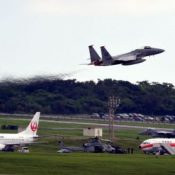
July 27, 2017 Ryukyu Shimpo
At around 9:17 a.m. on July 26, the landing light glass of an F-15 fighter jet belonging to the Naha Base of the Japan Air Self-Defense Force (JASDF) was damaged when it took off from Naha Airport.
According to the Naha Airport Office of the Ministry of Land, Infrastructure and Transport, the runway was closed for 47 minutes from 9:44 a.m. to 10:31 a.m. so that broken glass could be collected.
Twenty-six flights, including 11 arrival flights and 15 departure flights, were delayed for up to 52 minutes. Four flights were cancelled and five destinations were changed.
The JASDF’s Naha Base officials stated that the cause of the trouble was under investigation.
According to the Naha Base, a pilot of another F-15 fighter jet discovered that the landing light glass of his colleague’s fighter jet was broken immediately after takeoff.
The damaged fighter jet landed at the U.S. Air Force Kadena Air Base.
The JASDF inspected of the F-15 fighter jets.
Naha Base commander Kiyoaki Kawanami apologized saying, “We apologize for causing inconveniences to many people by closing the runway.”
(English translation by T&CT)
Go to Japanese

July 25, 2017 Ryukyu Shimpo
The Okinawan government filed a lawsuit in the Naha District Court against the Japanese federal government July 24, to prevent the destruction of rock on the seabed off the coast of Henoko in Nago as part of the new U.S. base construction. The prefectural government claims that continuing the construction without obtaining permission to damage the rock is illegal. Okinawa has also filed an injunction that halts construction until a decision is reached in the lawsuit. This will be the fifth legal battle between the Okinawan and central governments.
Governor Takeshi Onaga held a press conference at the prefectural office at 5:00 p.m. on July 24, criticizing the government’s position, saying, “the central government has arbitrarily changed its stance on fishing rights for the sake of the Henoko issue. We have drifted away from a being a nation of laws.” He added, “[This trial] is not to question if base construction is right or wrong, but rather questions the state for its stance to push through the new construction while disregarding the feelings of Okinawans.” Onaga stressed the importance of the lawsuit was to highlight the central government’s forceful position.
While answering questions from reporters, Onaga said, “We will inform both Okinawans and people all over Japan about the fishing rights problem, while challenging the outrageousness of the new base construction and the government’s hasty and rash behavior.”
In the lawsuit, the Okinawan government is arguing that fishing rights exists on the water designated for construction, and that the central government is required to obtain permission from the Okinawan government to damage rock on the seabed before beginning construction. Meanwhile, the government is arguing that the Nago fishing co-op has already relinquished their fishing rights, and that it is not necessary to obtain permission from the Okinawan government to damage the seabed rock.
In the Okinawan government’s claim, they argue that in articles 11 and 22 of the Fisheries Act, the “partial relinquishing” of the fishing rights granted to the Nago Co-op signify a “contraction” of the fishery, and that, “a fishery contraction corresponds to a ‘change,’ which has been the case since the Meiji Fishery Act, and naturally continues to govern the fishing industry to this day.” According to the prefectural government, any change in fishing rights requires the permission of the governor.
Furthermore, as the reason the Okinawan government is able to demand the central government apply for permission to destroy rock in the seabed was, Okinawa’s government is “the principal agent for protecting public interests such as preserving fishing resources,” and stressed that they have the executive right to make this type of permission request, “obligatory.”
(English translation by T&CT and Sam Grieb)
Go to Japanese
July 24, 2017 Ryukyu Shimpo online edition
On the afternoon of July 24, the Okinawa prefectural government brought a lawsuit against the central government, seeking to halt the ongoing construction work for a new base in Henoko. The prefectural government is arguing that the central government is acting illegally by not securing permission for damaging rock, and requesting that the central government apply for a renewal of permission with the prefectural government.
At 2:34 p.m., the prefectural government’s defense counsel filed its legal brief with the Naha District Court. In addition to trying to halt construction through this lawsuit, the prefectural government also filed an injunction to block the construction work before the court rules on the matter. In the evening on the same day, Governor Takeshi Onaga held a press conference and stated that once again Japan and Okinawa are bringing their conflicts concerning new base construction to the courts.
The prefectural government claims that fishing rights are granted in the waters where construction will take place, and it is necessary to get permission for damaging rock from the governor in order to push land reclamation work forward. However, the central government is asserting that the Nago Fisheries Cooperative has already decided to give up those fishing rights, making permission from the governor unnecessary. It remains to be seen what kind of decision the courts will make regarding whether or not there are fishing rights granted in the offshore construction area and whether renewal of permission for damaging rock is necessary for construction to continue.
In October 2015, the central government brought an “execution-by-proxy” lawsuit against Governor Onaga for revoking the land reclamation permission given by his predecessor for construction of the new base in Henoko, in which the sides reached an out-of-court settlement. But next, the central government brought a “declaration of illegality of inaction” lawsuit against Governor Onaga, which the prefectural government lost in December last year.
(English translation by T&CT and Erin Jones)
Go to Japanese
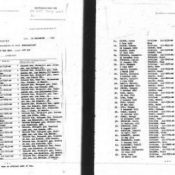
July 21, 2017 Ryukyu Shimpo
On July 20, a list of Okinawans who were captured during the Battle of Okinawa in 1945 and taken to a prison camp in Hawaii was found in the Okinawa Prefectural Archives. In February, Kaori Akiyama, who researches the compulsory detention of Japanese people in Hawaii at the Graduate University for Advanced Studies, found the list.
According to Akiyama, approximately 3,600 names are on the list. Many details such as the reasons for transferring Okinawan POWs to Hawaii remain unexplained in the studies of the Battle of Okinawa. Akiyama says, “It may lead to uncovering the whole picture.”
The Prefectural Archives got hold of the list from the United States National Archives. Since 2002, the Prefectural Archives has released the list with the title of “Military Police Long Mails.” In the list, prisoners’ names, class, ID numbers, and addresses are described in English.
According to Akiyama, the dates of registration are August 5, August 11, September 8, September 14, September 25, October 16, November 23, 1945.
At least 12 Okinawan POWs who were taken to Hawaii died in Hawaii. Their remains have not yet been found. In June, a memorial service was held in Hawaii for the first time. Families of victims and ex-POWs requested the Prefecture progress with the collection of remains.
(English translation by T&CT and Megumi Chibana)
Go to Japanese
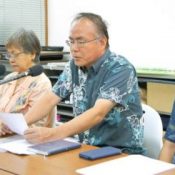
July 12, 2017 Ryukyu Shimpo
The All Okinawa Council, which stands against the new Henoko military base held a press conference on July 11 in Naha City to announce its plans for a rally for Okinawan people on August 12. The number of participants is anticipated to be around 30,000 people.
The rally is planned to start from 2PM at the Ohnoyama athletics stadium. Governor Onaga is also said to be considering joining the rally. Exective director Ryuji Yamamoto said, “we will continue our full support for the govenor’s lawsuit for suspending the construction until the case wins at court. As there will be a case filed next week, we see this rally as a clear signal of our determination to stop the illegal construction through legal action.”
Co-organizer, Suzuyo Takazato, said, “the country has been forcefully conducting construction work, but we would like to make sure that the people of Okinawa never give up. We would like to share our feeling widely and support the governor.”
The All Okinawa Council will make a second visit to California from August 16 to 24. The group will visit the Asian Pacific American Labor Alliance and local Okinawan communities as well as politicians to promote understanding about the current situations in Okinawa.
(English translation by T&CT and Sayaka Sakuma)
Go to Japanese
July 15, 2017 Ryukyu Shimpo
Phillippine Airlines will launch a direct chartered flight between Naha and Manila for six months from December. The news was announced on July 14. Mikiro Shimoji, a member of the Lower House, who was visiting the Philippines from July 11 to 13 met with Secretary Tugade from the Department of Transportation and other parties to make the decision. One monthly round-trip flight will be launched from September, and there will be two trips per month from December.
The flight will be a chartered flight for inbound visitors from the Philippines. The decision as to whether the flight should become a regular route or not will be made based the response to this route. Philippine Airlines had direct flights between Naha and Manila in 2003, however the route was cancelled in August 2007 due to declining customers. A direct flight between Manila and Naha was launched again this April after ten years.
(English translation by T&CT and Sayaka Sakuma)
Go to Japanese











 Webcam(Kokusai Street)
Webcam(Kokusai Street)


